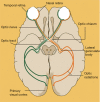Ophthalmic manifestations of endocrine disorders-endocrinology and the eye
- PMID: 29184810
- PMCID: PMC5682375
- DOI: 10.21037/tp.2017.09.13
Ophthalmic manifestations of endocrine disorders-endocrinology and the eye
Abstract
Disorders of the endocrine system usually manifest in a multi-organ fashion. More specifically, many endocrinopathies become apparent in the eye first through a variety of distinct pathophysiologic disturbances. The eye provides physicians with valuable clues for the recognition and management of numerous systemic diseases, including many disorders of the endocrine pathway. Recognizing ophthalmic manifestations of endocrine disorders is critical not only for rapid diagnosis and treatment, but also to prevent significant morbidity and mortality. In this review, we discuss relevant ophthalmic findings associated with key disorders of the pancreas, thyroid gland, and hypothalamic-pituitary axis, as well as with multiple hereditary endocrine syndromes. We have chosen to focus on diabetes mellitus (DM), Graves' ophthalmopathy, pituitary tumors, and some less common disorders that underscore the unique relationship between the eye and the endocrine system.
Keywords: Endocrine disease; Graves’ ophthalmopathy; diabetes mellitus (DM); eye disease; hypothalamic-pituitary axis; review; window.
Conflict of interest statement
Conflicts of Interest: The authors have no conflicts of interest to declare.
Figures










Similar articles
-
Ophthalmic clues to the endocrine disorders.J Endocrinol Invest. 2017 Jan;40(1):21-25. doi: 10.1007/s40618-016-0532-7. Epub 2016 Aug 27. J Endocrinol Invest. 2017. PMID: 27568184 Review.
-
The eye as a window to rare endocrine disorders.Indian J Endocrinol Metab. 2012 May;16(3):331-8. doi: 10.4103/2230-8210.95659. Indian J Endocrinol Metab. 2012. PMID: 22629495 Free PMC article.
-
Cloning and characterization of the novel thyroid and eye muscle shared protein G2s: autoantibodies against G2s are closely associated with ophthalmopathy in patients with Graves' hyperthyroidism.J Clin Endocrinol Metab. 2000 Apr;85(4):1641-7. doi: 10.1210/jcem.85.4.6553. J Clin Endocrinol Metab. 2000. PMID: 10770210
-
Eye Signs in Pituitary Disorders.Neurol India. 2019 Jul-Aug;67(4):979-982. doi: 10.4103/0028-3886.266265. Neurol India. 2019. PMID: 31512618 Review.
-
Diagnostic criteria for Graves' ophthalmopathy.Am J Ophthalmol. 1995 Jun;119(6):792-5. doi: 10.1016/s0002-9394(14)72787-4. Am J Ophthalmol. 1995. PMID: 7785696 Review.
Cited by
-
Ocular transmission and manifestation for coronavirus disease: a systematic review.Int Health. 2022 Mar 2;14(2):113-121. doi: 10.1093/inthealth/ihab028. Int Health. 2022. PMID: 34043796 Free PMC article.
-
Genome-wide polygenic risk score for retinopathy of type 2 diabetes.Hum Mol Genet. 2021 May 29;30(10):952-960. doi: 10.1093/hmg/ddab067. Hum Mol Genet. 2021. PMID: 33704450 Free PMC article.
-
Artificial Intelligence Models to Identify Patients at High Risk for Glaucoma Using Self-reported Health Data in a United States National Cohort.Ophthalmol Sci. 2024 Dec 17;5(3):100685. doi: 10.1016/j.xops.2024.100685. eCollection 2025 May-Jun. Ophthalmol Sci. 2024. PMID: 40151359 Free PMC article.
-
Thyroid Hormone Signaling in Retinal Development and Function: Implications for Diabetic Retinopathy and Age-Related Macular Degeneration.Int J Mol Sci. 2024 Jul 4;25(13):7364. doi: 10.3390/ijms25137364. Int J Mol Sci. 2024. PMID: 39000471 Free PMC article. Review.
-
Targeting the Ophthalmic Diseases Using Extracellular Vesicles 'Exosomes': Current Insights on Their Clinical Approval and Present Trials.Aging Dis. 2024 May 25;16(3):1225-1241. doi: 10.14336/AD.2024.0535. Aging Dis. 2024. PMID: 38913038 Free PMC article. Review.
References
-
- World Health Organization Global report on diabetes. Isbn 2016;978:88.
Publication types
LinkOut - more resources
Full Text Sources
Other Literature Sources
